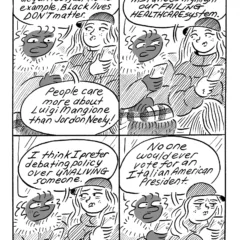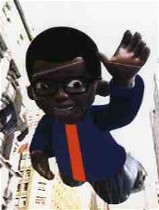 While all that political brouhaha emerged from the art world in time for the Republican Convention (see Roberta’s Saturday post), political art of a more enduring sort emerged uptown–at the Studio Museum in Harlem.
While all that political brouhaha emerged from the art world in time for the Republican Convention (see Roberta’s Saturday post), political art of a more enduring sort emerged uptown–at the Studio Museum in Harlem.
I was in New York as a stop on the way to my college roommate’s 40th wedding anniversary–she was practically a child bride, and believe it or not she met her husband when she was 14! What I was looking for to keep both me and Murray amused, was a group show with a lot of social content. And since I was staying on 125th Street, the shows at the SMH fit the bill.
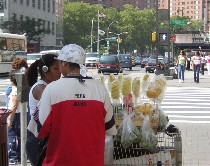 The walk on 125th Street in the heat was brutal, but I loved the pineapple- and mango-on-a-stick vendors (right) and I loved the crowds that grew and grew until we were near Lenox, where the crowds were as dense as on Fifth Avenue, and vendors hawked clothes and music and books.
The walk on 125th Street in the heat was brutal, but I loved the pineapple- and mango-on-a-stick vendors (right) and I loved the crowds that grew and grew until we were near Lenox, where the crowds were as dense as on Fifth Avenue, and vendors hawked clothes and music and books.
Upstairs at SMH, “Figuratively” showed work produced in nine months in the studio by SMH’s three artists in residence for this past year–Dave McKenzie, Wangechi Mutu and William Villalongo. The show was organized by Assistant Curator Christine Y. Kim, who had also curated the excellent “Black Belt” show at SMH (see our posts here and here).
All three artists had plenty to say and they said it beautifully, using self-portraiture mixed with the crazy cultural icons of our times to challenge stereotypes about themselves (a stretch, maybe for Villalongo, but I couldn’t help but think that his Cupid was a self-portrait) .
Wangechi Mutu
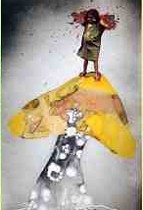 I’ll start with Kenya native Mutu, who had a small piece in the Altoids show that travelled to the Pennsylvania Academy of Fine Arts (see Roberta’s post here and mine here). The piece at the Altoids show was pretty subdued compared to the fabulous work in Harlem–full of explosions, high-tech machinery, fashion magazine cut outs, body innards and outards, and gorgeous painting–mostly of herself (left, “Mushwomb 3,” the figure in a USA t-shirt, her arms blown off).
I’ll start with Kenya native Mutu, who had a small piece in the Altoids show that travelled to the Pennsylvania Academy of Fine Arts (see Roberta’s post here and mine here). The piece at the Altoids show was pretty subdued compared to the fabulous work in Harlem–full of explosions, high-tech machinery, fashion magazine cut outs, body innards and outards, and gorgeous painting–mostly of herself (left, “Mushwomb 3,” the figure in a USA t-shirt, her arms blown off).
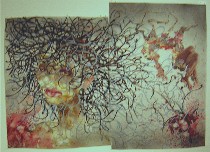 Mutu couldn’t fit the wild tresses in “Squiggly Wiggly Demon Hair” (right) on one sheet of paper, I guess, so the hair sprung over to a second piece, which also included a fall of wavy blond hair and a pair of crossed legs, both semi-attached to one of Mutu’s trademark contorted bodies. Her close-up face included fashion magazine shiny made-up lips and dark eyes collaged on, suggesting a mask. This is one of Mutu’s regular strategies, and she uses the collaged, slick fashion-industry generated eyes and lips in contrast to the vulnerable face or body that surrounds it. The eyes suggest someone looking at herself through others’ eyes, examining the discrepancy between who she is and how others see her.
Mutu couldn’t fit the wild tresses in “Squiggly Wiggly Demon Hair” (right) on one sheet of paper, I guess, so the hair sprung over to a second piece, which also included a fall of wavy blond hair and a pair of crossed legs, both semi-attached to one of Mutu’s trademark contorted bodies. Her close-up face included fashion magazine shiny made-up lips and dark eyes collaged on, suggesting a mask. This is one of Mutu’s regular strategies, and she uses the collaged, slick fashion-industry generated eyes and lips in contrast to the vulnerable face or body that surrounds it. The eyes suggest someone looking at herself through others’ eyes, examining the discrepancy between who she is and how others see her.
Somehow, Mutu gets into her pieces feminism, body politics, racial politics, racial identity, racial beauty, consumerism, violence, technology and fashion–all teetering on the brink of confusion and explosion yet holding together for the most part.
David McKenzie
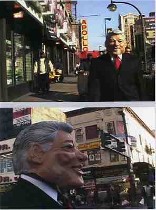 Sculptor and videomaker cum prankster McKenzie had me laughing along with all of Harlem with his video “We Shall Overcome” (left two images). He donned a Bill Clinton mask that covered his whole head and walked up 125th Street, waving, shaking hands, and handing out leaflets as Louis Armstrong and a gospel choir sang “We Shall Overcome” on the soundtrack. It was one joke over and over–the stranger in Mr. Rogers’ Neighborhood finally turns up–yet each encounter, with people and their multitude of reactions, held me gripped and wanting more.
Sculptor and videomaker cum prankster McKenzie had me laughing along with all of Harlem with his video “We Shall Overcome” (left two images). He donned a Bill Clinton mask that covered his whole head and walked up 125th Street, waving, shaking hands, and handing out leaflets as Louis Armstrong and a gospel choir sang “We Shall Overcome” on the soundtrack. It was one joke over and over–the stranger in Mr. Rogers’ Neighborhood finally turns up–yet each encounter, with people and their multitude of reactions, held me gripped and wanting more.
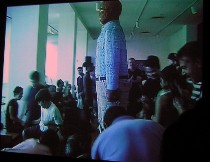 Another video, “Self Portrait Pinata” (right) recorded a party for children at the Queens Museum in which the children cheered on as a young man whacked at a pinata of the artist. The event was at once funny and horrifying, bringing up memories of lynchings and beatings. Even the pinata’s conservative look–light blue shirt, khakis, glasses–couldn’t protect him. After the pinata spilled its treasure, children thrust their legs into the broken-off pinata legs and shuffled along, or thrust their heads into the pinata body. Their imperviousness to the plight of the pinata, which had become a human to me, was disturbing too.
Another video, “Self Portrait Pinata” (right) recorded a party for children at the Queens Museum in which the children cheered on as a young man whacked at a pinata of the artist. The event was at once funny and horrifying, bringing up memories of lynchings and beatings. Even the pinata’s conservative look–light blue shirt, khakis, glasses–couldn’t protect him. After the pinata spilled its treasure, children thrust their legs into the broken-off pinata legs and shuffled along, or thrust their heads into the pinata body. Their imperviousness to the plight of the pinata, which had become a human to me, was disturbing too.
And McKenzie’s persona reduced to a kitschy object again shows up in his video, “Watch the Sky,” (top of post) in which his face and eyeglasses appear again, his features exaggerated, over the face of the Little Bill float in the Macy’s Thanksgiving Day Parade–transforming himself into an ambiguous superhero/antihero caricature.
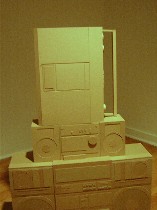 And a short-short video of the artist lifting a lit-up finger tip to his nostril, thereby lighting up the tip of his nose. It was worth the price of admission.
And a short-short video of the artist lifting a lit-up finger tip to his nostril, thereby lighting up the tip of his nose. It was worth the price of admission.
Of McKenzie’s sculptures, my favorite was a waist-high cardboard boom box, “A Small Monument.” It was open to contradictory interpretations–a source of pride, a source of embarrassment. The choice of Kraft-paper brown reinforced the ambiguity. At the same time, the piece managed to raise questions about what makes something worthy of being raised to monument status. I was just looking through Roberta’s Ben Katchor book (see post), and he too raises that question. So is it white folks values? black folks values? this year’s values? last year’s?
William Villalongo
Villalongo offers wry commentary on the state of race relations in America with flat, large painting/collages full of hard-edged shapes intertwined and influenced by baroque paintings. He paints in layers of acrylic over black velvet and adds crowds of putti, cut out of paper, and laid on the surface. The colors are beautiful, rich, and restful, making the intense compositions possible to look at. These are visual tour de forces that look like hard-edge acrylic designs until you look closer. He also makes cut-out line drawings on black velvet paper with similar subject matter.
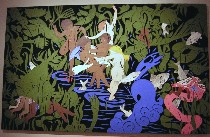 In “Love Before the Colonization of Mars,” putti and aliens — all dropped down from outer space to a gorgeous jungly environment– have an orgy, and in “Dirty Diana and the Beast with 40 Eyes” (right), quoting from William Bouguereau’s “Nymphs and Satyr,” Villalongo shows Cupid (himself?) being dragged by sexy ladies to an uncertain fate as putti lurk beneath the greenery or get chewed up by the 40-eyed pink beast in the right hand corner. These images show a world without rules, where playfulness and danger are love partners.
In “Love Before the Colonization of Mars,” putti and aliens — all dropped down from outer space to a gorgeous jungly environment– have an orgy, and in “Dirty Diana and the Beast with 40 Eyes” (right), quoting from William Bouguereau’s “Nymphs and Satyr,” Villalongo shows Cupid (himself?) being dragged by sexy ladies to an uncertain fate as putti lurk beneath the greenery or get chewed up by the 40-eyed pink beast in the right hand corner. These images show a world without rules, where playfulness and danger are love partners.
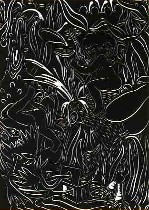 The paper cut-out pictures (right) are also filled with ancient, mythological beasts and references, but the content also veers into lynchings and stereotypes. Wild, polytheistic, writhing nature and compressed imagery take on a less humorous tone in these intense images that rely less on the latest in pop culture.
The paper cut-out pictures (right) are also filled with ancient, mythological beasts and references, but the content also veers into lynchings and stereotypes. Wild, polytheistic, writhing nature and compressed imagery take on a less humorous tone in these intense images that rely less on the latest in pop culture.
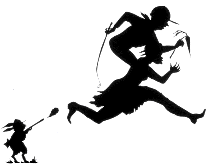 The gallery notes avoided mentioning the name Kara Walker in the discussion of these cut-outs. I can only suppose it’s the writer trying to protect Villalongo from the vitriol that has been thrown at Walker for the ambiguities in her use of silhouettes to redefine stereotyped views of African Americans. But anyone using cut-out paper to grapple with racial issues has to be aware of Walker’s silhouettes. Villalongo is also working in black and white here, and although he cuts out the lines, not the fill, he too is using the past, its stories and its imagery, to redefine the present and take possession of it.
The gallery notes avoided mentioning the name Kara Walker in the discussion of these cut-outs. I can only suppose it’s the writer trying to protect Villalongo from the vitriol that has been thrown at Walker for the ambiguities in her use of silhouettes to redefine stereotyped views of African Americans. But anyone using cut-out paper to grapple with racial issues has to be aware of Walker’s silhouettes. Villalongo is also working in black and white here, and although he cuts out the lines, not the fill, he too is using the past, its stories and its imagery, to redefine the present and take possession of it.
All three of these artists are worth a trip to New York.


